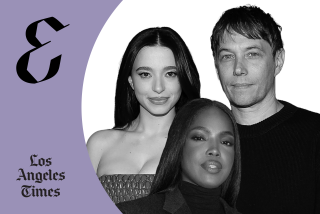Baz Luhrmann shows hip-hop’s origin in Netflix’s ‘The Get Down.’ Beats weren’t the only challenges
- Share via
Even for a filmmaker with a knack for staging lavish spectacles laced with pop-music hits – think “Moulin Rouge!” and “The Great Gatsby” – Baz Luhrmann found the process of making “The Get Down,” his new Netflix series about the dawn of hip-hop in 1970s New York City, uniquely daunting.
A white Australian raised in a backwater town in New South Wales, Luhrmann is by his own admission hardly the most obvious candidate to tell a story about underprivileged black and Latino teenagers from the outer boroughs.
For a director with an exacting reputation making his first television series, the transition to serialized storytelling, in a medium typically dominated by writers, also presented a steep learning curve.
Add to that the challenge of re-creating derelict ’70s New York City in an era when even the South Bronx has been gentrified, a soundtrack stuffed with disco hits and original tunes by Nas, and a cast led by unknowns who had to be trained in disco, break dance, graffiti and record-spinning, and it’s little wonder “The Get Down” faced multiple production delays and reportedly cost more than $120 million.
The first half of the 12-episode season finally arrives Aug. 12 on Netflix.
While neither the streaming service nor Sony Pictures Television, the studio behind “The Get Down,” would comment on its budget, in a recent telephone interview Luhrmann was candid about the difficulties of realizing his vision.
“Right now I don’t know if I’m going to be able to walk out of this building standing up,” said the director, who cycled through two show runners before eventually taking the reins himself.
Luhrmann began what he calls the “epic journey” of making “The Get Down” about a decade ago in a Paris cafe where he saw a picture of two New York City teenagers taken by street photographer Jamel Shabazz, in the late ’70s.
A thought occurred to him: “Very rarely does a completely new idea come along in popular culture. How did one come along that started in a borough that no one cared about but went on to transform the world?”
Though he initially pitched “The Get Down” as a movie, Luhrmann was eventually lured to the small screen. He joins a growing list of acclaimed filmmakers who’ve migrated to television, but the transition isn’t always successful. This year alone, two music-themed series from big-name directors — Martin Scorsese’s “Vinyl” and Cameron Crowe’s “Roadies” — both fizzled.
Opening in the arson-ravaged South Bronx during the infamous summer of 1977, when the Son of Sam killer and a chaotic blackout had the city on edge, “The Get Down” is an origin story told from the perspective of the b-boys and MCs who pioneered a revolutionary new art form.
In the 90-minute pilot episode, directed by Luhrmann, we meet Zeke, aka “Books” (Justice Smith), a soulful teenage poet destined to become a major ’90s rap star (played as an adult by “Hamilton” star Daveed Diggs). He pines after Mylene (Herizen F. Guardiola), a preacher’s daughter with disco-diva dreams, and eventually befriends Shaolin (Shameik Moore), a graffiti artist and aspiring DJ. Both boys become disciples of Grandmaster Flash (Mamoudou Athie), reimagined by Luhrmann as a mystical urban sensei.
“The Get Down” captures a period of relative innocence in rap history, “a time before the big record companies got invested” and the music was more purely creative, said Nas, an executive producer on the series.
With elaborate song-and-dance numbers in each episode and an array of references to such ’70s touchstones as “Saturday Night Fever,” “The Warriors” and the films of Bruce Lee, “The Get Down” continues in the exuberant, referential style of Luhrmann’s other work.
But unlike with “Strictly Ballroom” or “Australia,” Luhrmann had to approach the subject of “The Get Down” with particular care, lest he be accused of whitewashing or cultural appropriation.
“The industry has a long track record of telling these stories from the point of view of outsiders. That was an initial concern of mine, especially for a community that concerns itself with quote-unquote keeping it real,” said writer and co-executive producer Aaron Rahsaan Thomas, who was excited to work on a rare TV drama centered on young African American males. “From day one, it’s always been something that [Luhrmann] has been extremely sensitive to.”
The writers room, diverse by design, leaned heavily toward native New Yorkers and playwrights, like Stephen Adly Guirgis (“The Mother… With the Hat”) and Seth Zvi Rosenfeld (“How to Make It In America”). Originally led by Shawn Ryan (“The Shield”) out of Los Angeles, it was eventually moved to New York at Luhrmann’s behest — all in a bid for authenticity.
Luhrmann also enlisted rap trailblazers Nas, whose songs were incorporated into the narrative, and Grandmaster Flash, who helped train the cast in the finer points of rhyming and spinning. Well-known graffiti artists and choreographers of the day also lent their expertise, as did Nelson George, a producer and journalist who’s written extensively about the history of hip-hop.
Given the arduousness of putting together the show’s first season, the inevitable question becomes whether Luhrmann would be up for another go-around.
“When I’m having a mild sherry at night I think, gee, imagine what we could do in the ’80s,” he says. “I would never abandon the show. But I’m getting on. I want to develop and help young people to carry on the mantle.”
More to Read
The complete guide to home viewing
Get Screen Gab for everything about the TV shows and streaming movies everyone’s talking about.
You may occasionally receive promotional content from the Los Angeles Times.






